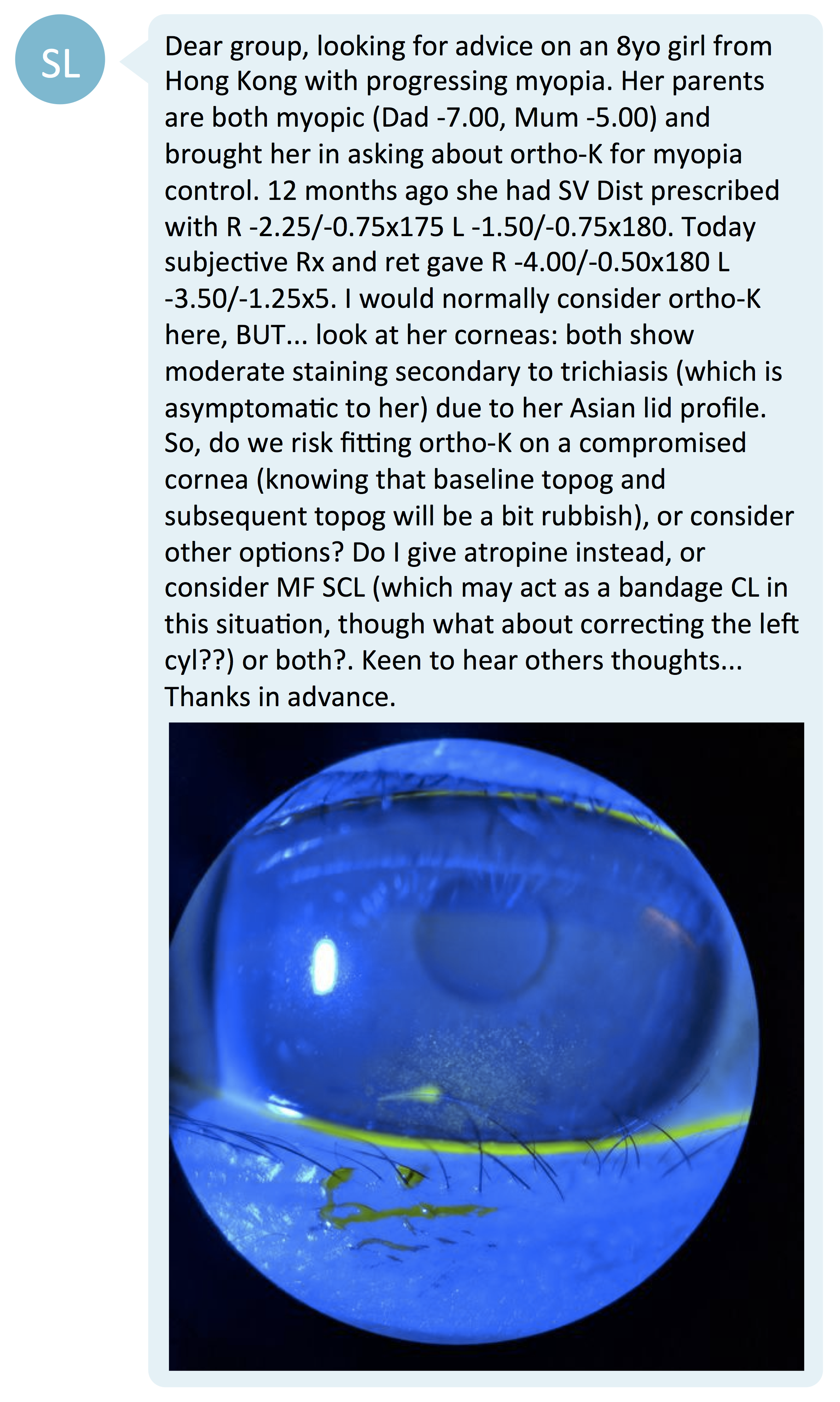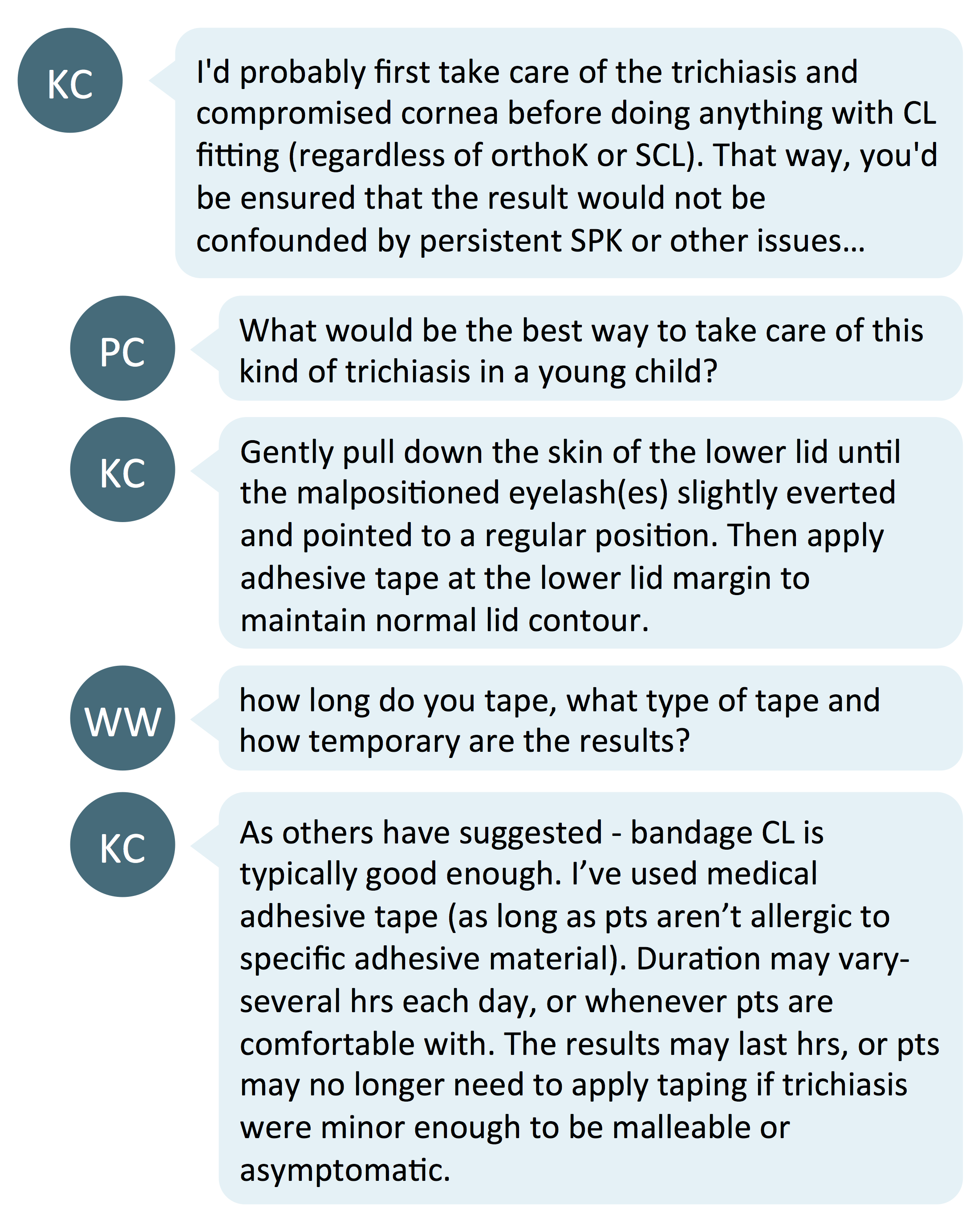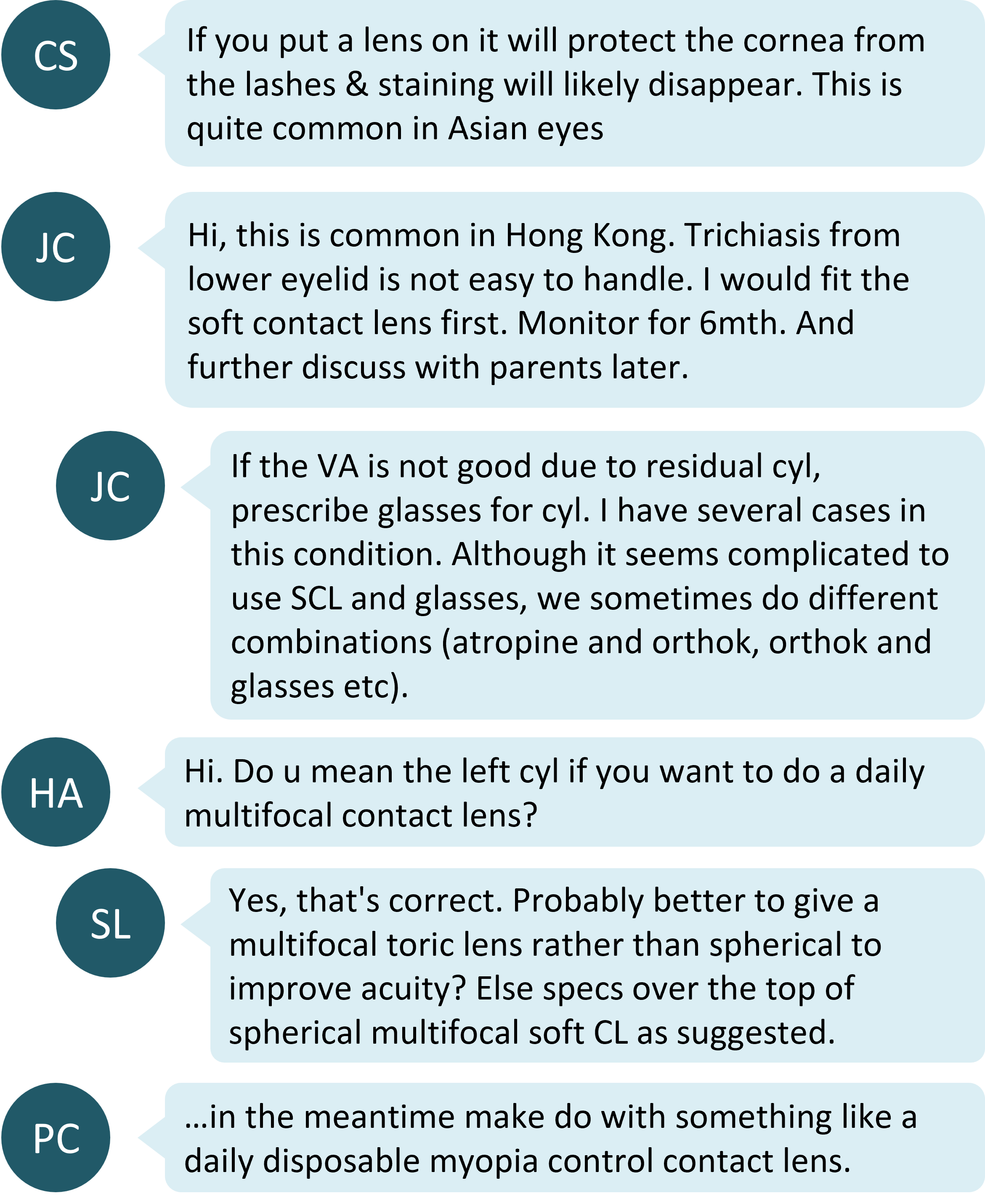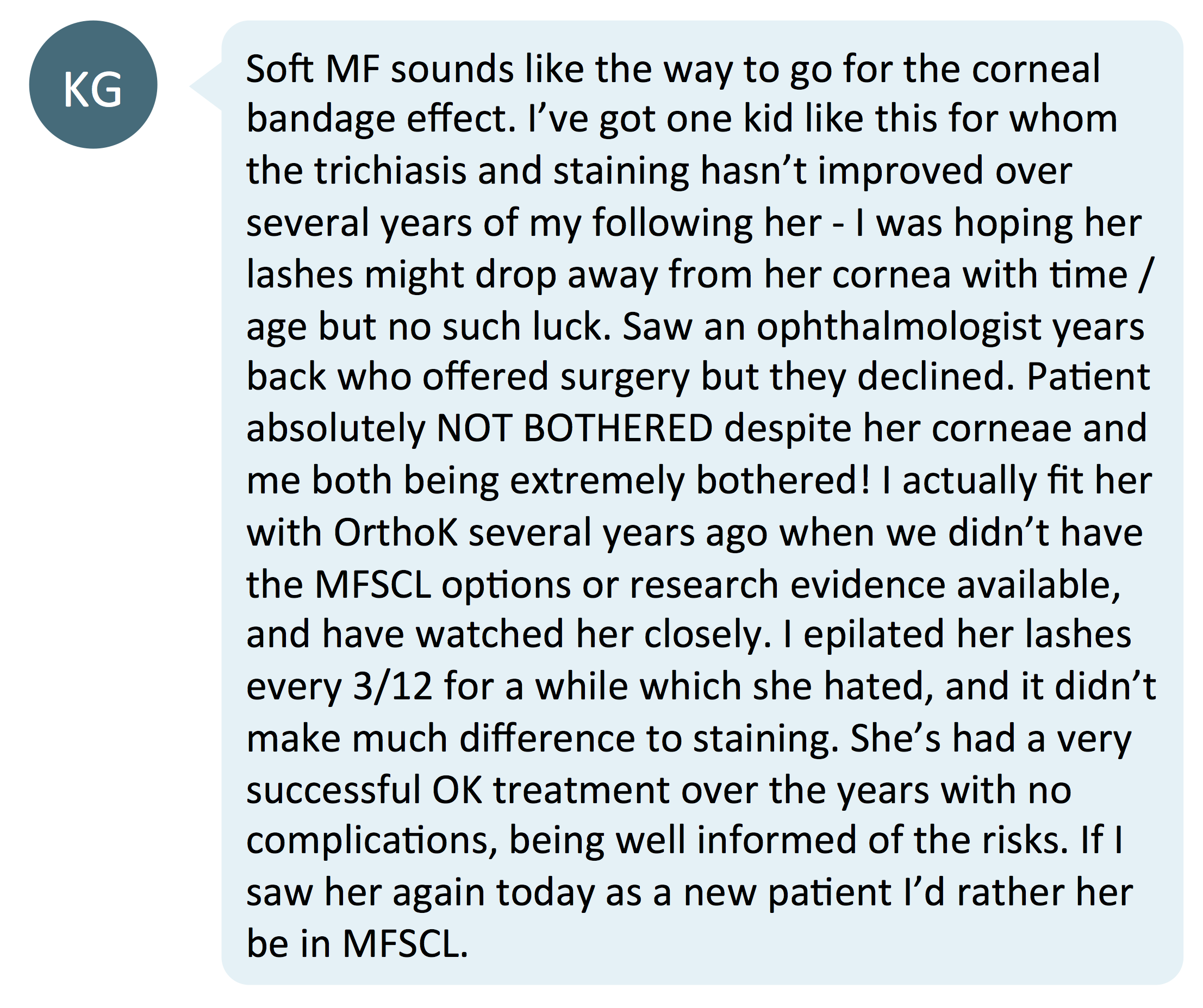Orthokeratology (ortho-k) contact lenses are one of the most effective treatments for myopia control.1,2 Candidates for contact lens myopia control options, such as soft contact lenses or ortho-k, need to have a healthy ocular surface to avoid undue risk of complications or infections with contact lens wear.3
Here, SL shared a case involving an 8-year-old child who has fast progressing myopia, enquiring about ortho-k to reduce this rate of progression. However, she also has moderate corneal staining secondary to trichiasis. What would you do to ensure you focus on safety, while properly considering myopia control?

The first order of business in fitting contact lenses to a compromised cornea is to address corneal staining. In this case, trichiasis is the root problem that requires attention. Commenters from the Myopia Profile Facebook community have shared a few interesting ideas:
Part 1: Addressing the eyelids and eyelashes before fitting contact lenses

Lid taping can reduce the signs and symptoms of triachiasis temporarily.4-7 This can be done by gently everting the lower eyelid to redirect the eyelashes away from the cornea and applying a piece of tape to hold it in place whilst ensuring the patient is able to open and close the eyes naturally.6 This is a short-term fix and may not necessarily command good patient compliance.
Eyelash fix 1: Epilation

One can remove the lashes by forceps (epilation). However, recurrence can occur within 4-6 weeks depending on the growth of lashes.7
Eyelash fix 2: Surgery
Unlike the above methods, surgery is a long-lasting solution for triachiasis. There are several types of surgery which all essentially aim to tighten the eyelid and redirect the eyelashes away from the cornea. Recurrence is relatively low (0-30% depending on technique) with good patient selection.8 One can consult a specialist ophthalmologist for guidance on the most suitable treatment.
Part 2: Discussion about myopia control options
Soft contact lens as a bandage

A popular option was to use a multifocal or myopia control soft contact lens as a bandage lens ,as well as to slow the myopia progression. It has been shown that a combination of lubricating eye drops with a bandage contact lens can promote corneal healing.9 Given the degree of astigmatism in the patient’s left eye, a toric multifocal soft contact lens may be necessary, but there is no evidence base for any such designs.
All multifocal10,11 and myopia controlling12,13 soft contact lenses currently available are spherical designs, and their research studies typically recruit participants with up to 0.75DC.10-13 Off-label considerations can also be required: read more in Understanding on- and off-label prescribing. Only ortho-k has evidence for myopia control in the presence of higher levels of astigmatism; up to 3.50DC.14
Spectacles

In addition to the benefit of myopia control, contact lenses offer numerous benefits to children compared to spectacles, such as increased confidence, ability to participate in activites, and satisfaction with their vision. This is true for both soft contact lenses15 and ortho-k.16
The risk-benefit balance is different, though, for a child with corneal epithelial defects.1 This is where spectacle options are a worthy contender as they mitigate the risk involved with fitting a contact lens on a compromised cornea. The newest designs of myopia controlling spectacle lenses appear to have similar efficacy to ortho-k and the more effective myopia controlling soft contact lenses.2 Spectacles, though, do not address the corneal impact of trichiasis whereas a soft contact lens can be used as a bandage lens to support corneal healing.9
Would atropine suitable in this case?

Low-dose atropine may be suitable, but in the context of an intact cornea. While atropine with spectacle lens wear does not expose the patient to the risks of contact lens wear, commenters suggest that the preservatives (typical in bottled and compounded formulations) may increase ocular irritation, especially if the epithelial defects have not been resolved. Levrat et al corroborate this, as they found that patients treated with preserved eye drops exhibited more signs and symptoms of ocular surface compromise when compared to those treated with unpreserved eye drops.17
A case example

Incidentally, KG shared her experience with a similar patient suffering from chronic, although asymptomatic, trichiasis with corneal staining. This patient was wearing ortho-k, being watched closely, and had her trichiatic eyelashes epilated every three months. While this patient was wearing ortho-k successfully, without incident, a soft contact lens option could be preferable in the current day, with more evidence and options now available.
Take home messages:
In summary, it is easiest to consider the options depending on whether the patient’s cornea is compromised or not.
- One could concentrate on resolving the epithelial defects by applying short-term or long-term solutions to address the trichiasis then proceed to manage the patient as normal.
- If the epithelial defects are not first resolved, then ortho-k and preserved atropine options become less favourable, with multifocal or myopia controlling soft contact lens and spectacle options having a higher safety profile.
- Ultimately, parents have to be aware of the risks involved with contact lens wear on a compromised eye, be alert for any signs of complications, and be informed of the importance of regular follow up to monitor the child’s ocular health.

About Kimberley
Kimberley Ngu is a clinical optometrist from Perth, Australia, with experience in patient education programs, having practiced in both Australia and Singapore.

About Connie
Connie Gan is a clinical optometrist from Kedah, Malaysia, who provides comprehensive vision care for children and runs the myopia management service in her clinical practice.
This content is brought to you thanks to an unrestricted educational grant from
![]()
References
- Sun Y, Xu F, Zhang T, Liu M, Wang D, Chen Y, Liu Q. Orthokeratology to control myopia progression: a meta-analysis. PLoS One. 2015 Apr 9;10(4):e0124535.
- Brennan NA, Toubouti YM, Cheng X, Bullimore MA. Efficacy in myopia control. Prog Retin Eye Res. 2021 Jul;83:100923.
- Wolffsohn JS, Dumbleton K, Huntjens B, Kandel H, Koh S, Kunnen CME, Nagra M, Pult H, Sulley AL, Vianya-Estopa M, Walsh K, Wong S, Stapleton F. CLEAR - Evidence-based contact lens practice. Cont Lens Anterior Eye. 2021 Apr;44(2):368-397.
- Camara JG, Chan MQ, Ruszkowski JM, Worak SR, Peralta RV. Use of adhesive tape for temporary management of inturned upper eyelid eyelashes. Archives of Ophthalmology. 2012 May 1;130(5):635-8. (link)
- Karesh J. Involutional Lower Eyelid Entropion. InManual of Oculoplastic Surgery 2018 (pp. 229-238). Springer, Cham. (link)
- Stevens S. Taping an eyelid closed. Community eye health. 2012;25(78):36. (link)
- Kirkwood BJ, Kirkwood RA. CE-Trichiasis: Characteristics and Management Options. Insight-The Journal of the American Society of Ophthalmic Registered Nurses. 2011;36(2):5. (link)
- Marcet MM, Phelps PO, Lai JS. Involutional entropion: risk factors and surgical remedies. Current opinion in ophthalmology. 2015 Jul 1;26(5):416-21. (link)
- Schrader S, Wedel T, Moll R, Geerling G. Combination of serum eye drops with hydrogel bandage contact lenses in the treatment of persistent epithelial defects. Graefe's Archive for Clinical and Experimental Ophthalmology. 2006 Oct 1;244(10):1345-9. (link)
- Cooper J, OʼConnor B, Watanabe R, Fuerst R, Berger S, Eisenberg N, Dillehay SM. Case Series Analysis of Myopic Progression Control With a Unique Extended Depth of Focus Multifocal Contact Lens. Eye Contact Lens. 2018 Sep;44(5):e16-e24.
- Walline JJ, Walker MK, Mutti DO, Jones-Jordan LA, Sinnott LT, Giannoni AG, Bickle KM, Schulle KL, Nixon A, Pierce GE, Berntsen DA. Effect of high add power, medium add power, or single-vision contact lenses on myopia progression in children: the BLINK randomized clinical trial. JAMA. 2020 Aug 11;324(6):571-80.
- Chamberlain P, Bradley A, Arumugam B, Hammond D, McNally J, Logan NS, Jones D, Ngo C, Peixoto-de-Matos SC, Hunt C, Young G. Long-term Effect of Dual-focus Contact Lenses on Myopia Progression in Children: A 6-year Multicenter Clinical Trial. Optom Vis Sci. 2022 Mar 1;99(3):204-212.
- Sankaridurg P, Bakaraju RC, Naduvilath T, Chen X, Weng R, Tilia D, Xu P, Li W, Conrad F, Smith EL 3rd, Ehrmann K. Myopia control with novel central and peripheral plus contact lenses and extended depth of focus contact lenses: 2 year results from a randomised clinical trial. Ophthalmic Physiol Opt. 2019 Jul;39(4):294-307.
- Chen C, Cheung SW, Cho P. Myopia control using toric orthokeratology (TO-SEE study). Invest Ophthalmol Vis Sci. 2013 Oct 3;54(10):6510-7.
- Walline JJ, Gaume A, Jones LA, Rah MJ, Manny RE, Berntsen DA, Chitkara M, Kim A, Quinn N. Benefits of contact lens wear for children and teens. Eye Contact Lens. 2007;33(6 Pt 1):317-321.
- Santodomingo-Rubido J, Villa-Collar C, Gilmartin B, Gutiérrez-Ortega R. Myopia control with orthokeratology contact lenses in Spain: a comparison of vision-related quality-of-life measures between orthokeratology contact lenses and single-vision spectacles. Eye Contact Lens. 2013 Mar;39(2):153-7.
- Levrat F, Pisella PJ, Baudouin C. Clinical tolerance of antiglaucoma eyedrops with and without a preservative. Results of an unpublished survey in Europe. Journal Francais d'Ophtalmologie. 1999 Mar 1;22(2):186-91. (link)











